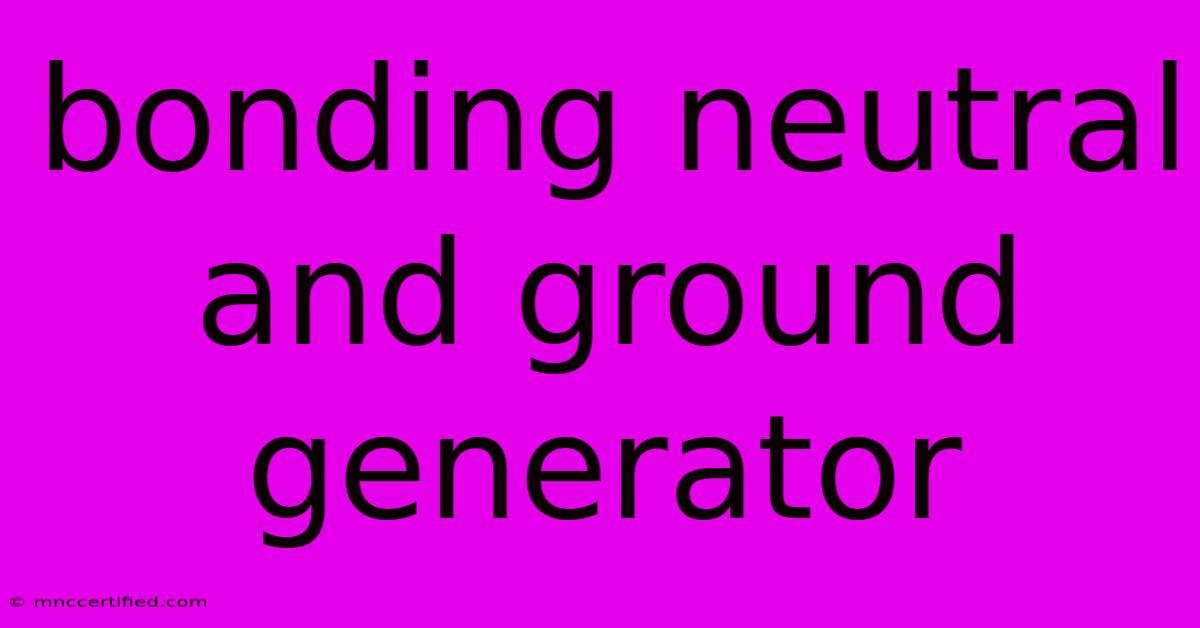Bonding Neutral And Ground Generator

Table of Contents
Bonding Neutral and Ground: A Comprehensive Guide for Generator Owners
Generators are a vital lifeline during power outages, but their safe operation relies on proper grounding and bonding. While these concepts might sound technical, understanding them is crucial for ensuring the safety of your home and appliances. This guide will break down the key aspects of bonding neutral and ground in a generator system, helping you make informed decisions.
What is Bonding and Grounding?
Grounding refers to connecting a conductive part of an electrical system to the earth. This provides a low-resistance path for fault currents to flow to the ground, protecting people and equipment from electric shock. Bonding, on the other hand, connects different conductive parts of a system together, ensuring that they are at the same electrical potential. This prevents dangerous voltage differences that can lead to electric shock.
Why Bond Neutral and Ground in a Generator System?
Bonding the neutral and ground in a generator system serves several critical purposes:
- Safety: It creates a safe pathway for fault currents to flow to the ground, preventing dangerous voltages from building up in the system.
- Voltage Regulation: Bonding ensures that the neutral and ground are at the same potential, maintaining proper voltage levels and preventing potential damage to sensitive electronics.
- Ground Fault Protection: In the event of a ground fault, the bonding connection allows the circuit breaker to trip, interrupting the flow of current and preventing electric shock or fire.
How to Bond Neutral and Ground in a Generator System
There are two primary methods for bonding neutral and ground in a generator system:
1. Through the Generator Panel: Many portable generators have a built-in bonding terminal. This terminal connects the generator's neutral to the generator's ground, creating a bonded neutral-ground connection. This method is simpler to implement but might not be suitable for larger, permanent generator installations.
2. Through a Dedicated Bonding Jumper: In permanent generator installations, a dedicated bonding jumper is used to connect the generator's neutral to the ground rod outside the generator enclosure. This jumper is typically a heavy-duty cable that is properly sized to handle the fault current. This method ensures a robust and reliable connection for high-power applications.
Importance of Professional Installation
Bonding neutral and ground in a generator system is a complex procedure. It is strongly advised to have a licensed electrician perform the installation. Attempting to bond these connections yourself can lead to safety hazards and potentially damage your electrical system.
Key Considerations for Safe Generator Operation
- Properly Size the Generator: Ensure your generator is adequately sized for your home's electrical needs.
- Use Transfer Switch: A transfer switch is essential for safely connecting your generator to your home's electrical system.
- Regular Maintenance: Regularly inspect and maintain your generator to ensure its safety and optimal performance.
Conclusion
Bonding neutral and ground in a generator system is crucial for safety and reliable operation. It provides a pathway for fault currents, prevents voltage discrepancies, and safeguards your home and appliances. While the concepts might seem complex, understanding the fundamentals is essential for protecting yourself and your property. Always prioritize safety by consulting a licensed electrician for proper installation and maintenance.

Thank you for visiting our website wich cover about Bonding Neutral And Ground Generator. We hope the information provided has been useful to you. Feel free to contact us if you have any questions or need further assistance. See you next time and dont miss to bookmark.
Featured Posts
-
Additional Insured Renters Insurance
Nov 11, 2024
-
Curry Sinks Clutch Shot In Warriors Victory
Nov 11, 2024
-
Mc Caffrey Hype Builds For 49ers Season
Nov 11, 2024
-
Florida 215 Insurance Exam Questions
Nov 11, 2024
-
The Mirror And The Light Bbc One Review
Nov 11, 2024